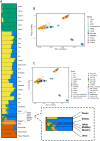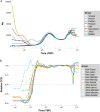Sequence analyses of Malaysian Indigenous communities reveal historical admixture between Hoabinhian hunter-gatherers and Neolithic farmers
- PMID: 35962005
- PMCID: PMC9374673
- DOI: 10.1038/s41598-022-17884-8
Sequence analyses of Malaysian Indigenous communities reveal historical admixture between Hoabinhian hunter-gatherers and Neolithic farmers
Abstract
Southeast Asia comprises 11 countries that span mainland Asia across to numerous islands that stretch from the Andaman Sea to the South China Sea and Indian Ocean. This region harbors an impressive diversity of history, culture, religion and biology. Indigenous people of Malaysia display substantial phenotypic, linguistic, and anthropological diversity. Despite this remarkable diversity which has been documented for centuries, the genetic history and structure of indigenous Malaysians remain under-studied. To have a better understanding about the genetic history of these people, especially Malaysian Negritos, we sequenced whole genomes of 15 individuals belonging to five indigenous groups from Peninsular Malaysia and one from North Borneo to high coverage (30X). Our results demonstrate that indigenous populations of Malaysia are genetically close to East Asian populations. We show that present-day Malaysian Negritos can be modeled as an admixture of ancient Hoabinhian hunter-gatherers and Neolithic farmers. We observe gene flow from South Asian populations into the Malaysian indigenous groups, but not into Dusun of North Borneo. Our study proposes that Malaysian indigenous people originated from at least three distinct ancestral populations related to the Hoabinhian hunter-gatherers, Neolithic farmers and Austronesian speakers.
© 2022. The Author(s).
Conflict of interest statement
The authors declare no competing interests.
Figures




Similar articles
-
Insights into the demographic history of Asia from common ancestry and admixture in the genomic landscape of present-day Austroasiatic speakers.BMC Biol. 2021 Mar 29;19(1):61. doi: 10.1186/s12915-021-00981-x. BMC Biol. 2021. PMID: 33781248 Free PMC article.
-
Genomic structure of the native inhabitants of Peninsular Malaysia and North Borneo suggests complex human population history in Southeast Asia.Hum Genet. 2018 Feb;137(2):161-173. doi: 10.1007/s00439-018-1869-0. Epub 2018 Jan 30. Hum Genet. 2018. PMID: 29383489
-
Unravelling the genetic history of Negritos and indigenous populations of Southeast Asia.Genome Biol Evol. 2015 Apr 14;7(5):1206-15. doi: 10.1093/gbe/evv065. Genome Biol Evol. 2015. PMID: 25877615 Free PMC article.
-
Ancient DNA elucidates the migration and evolutionary history of northern and southern populations in East Asia.Yi Chuan. 2025 Jan;47(1):18-33. doi: 10.16288/j.yczz.24-224. Yi Chuan. 2025. PMID: 39791296 Review.
-
Origin of ethnic groups, linguistic families, and civilizations in China viewed from the Y chromosome.Mol Genet Genomics. 2021 Jul;296(4):783-797. doi: 10.1007/s00438-021-01794-x. Epub 2021 May 26. Mol Genet Genomics. 2021. PMID: 34037863 Review.
Cited by
-
Plasmid-Mediated Co-Occurrence of mcr-1.1 in Extended-Spectrum β-Lactamase (ESBL)-Producing Escherichia coli Isolated From the Indigenous Seminomadic Community in Malaysia.Transbound Emerg Dis. 2024 Oct 9;2024:9223696. doi: 10.1155/2024/9223696. eCollection 2024. Transbound Emerg Dis. 2024. PMID: 40303148 Free PMC article.
References
-
- Eberhard D, Simons G, Fennig C. Ethnologue: Languages of the World. 23. Dallas: SIL International; 2020.
-
- Conrad C. Encyclopedia of Global Archaeology. Cham: Springer International Publishing; 2018.
-
- Hung HC. Encyclopedia of Global Archaeology. Cham: Springer International Publishing; 2018. pp. 1–22.
Publication types
MeSH terms
Grants and funding
LinkOut - more resources
Full Text Sources

